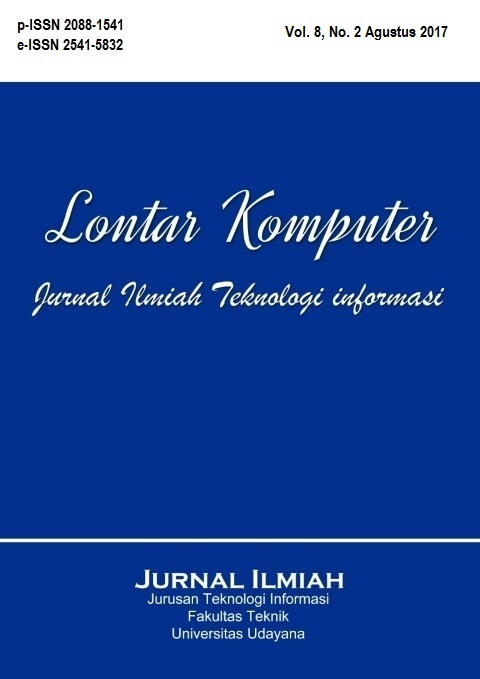Implementasi Keamanan Data Menggunakan Algoritma Rivest Code 4 (RC4) Pada Sistem Informasi Inventory Stock Barang Pada Distributor PT.Wings Food
Abstract
Rivest code 4 (RC4) is a cryptographic algorithm modern symentic key which has an operating mode stream chipper. It’s used two substitutions box in processing data and information, they are array with a permutation length of 256 and second s-box as permutation with has a function as public key. Algorithm rivest code 4 was used for data encryption, message or information. Information system inventory stock of goods at distributor PT. Wings Food is a system that processed incoming and outgoing goods data, so that the data stored in database must be guaranteed confidential and its secure. To keep the security of stock data items stored in database, it was combined with algorithm rivest code 4. Thus, the data encrypted in database would not be known the real meaning and was difficult to change or replaced. Symmetry key that was used for processing encryption and description rivest code 4 algorithm at information system inventory stock of goods in source code. Algorithm implementation rivest code 4 was made by programming language Hypertext Preprocessor and MySQL. Based on the result, the data displayed in database PT. Wings Food was encrypted, so it was found that the system could keep the data confidential in a secure. In short, the data displayed was unencrypted.
Downloads
References
[2] J. Pagik, “Pengertian Algoritma RC4,” 2014. [Online]. Available: https://matriasiyas.wordpress.com/2014/01/19/pengertian-algoritma-rc4/. [Accessed: 01-Jun-2017].
[3] A. A. I. A. D. Purnamaningrat, I. M. Sukarsa, and N. M. I. Marini, “Perancangan Sistem Informasi Manajemen Rumah Sakit Modul Sarana dan Prasarana,” Lontar Komput. J. Ilm. Teknol. Inf., vol. 6, no. 2, pp. 73–83, 2015.
[4] S. Kosasi, “Penerapan Rapid Application Development pada Sistem Penjualan Sepeda Online,” J. Simetris, vol. 6, no. 1, pp. 27–36, 2015.
[5] R. Sadikin, Kriptografi untuk Keamanan Jaringan, 1st ed. Yogyakarta: AndiPublisher, 2012.
[6] W. H. Haji and S. Mulyono, “Implementasi Rc4 Stream Cipher Untuk Keamanan Basis Data,” Implementasi Rc4 Stream Cipher Untuk Keamanan Basis Data, 2012.
[7] D. Hostiadi and I. B. Suradarma, “Implementasi Pengaman PGP pada Platform Zimbra Mail Serve,” Lontar Komput. J. Ilm. Teknol. Inf., vol. 8, no. 1, pp. 41–52, 2017.
[8] W. Lestari, “Aplikasi Algoritma Kriptografi dan Steganografi Untuk Kemanan Informasi Berbasis Teks,” Politeknosains, vol. 15, no. 2, 2016.
[9] J. Enterprise, Belajar Java, Database, dan netBeans dari nol. Yogyakarta: Elex Media Komputindo, 2016.
[10] R. A.S and M. Shalahuddin, Rekayasa Perangkat Lunak. Bandung: Informatika, 2013.
[11] D. Abdullah and C. Erliana, “Perancangan Sistem Informasi Inventori Barang pada CV. Iltizam Cooperation,” Syntax, vol. 3, no. 1, 2014.
[12] A. Fitriya, M. Nurkamid, and T. Khotimah, “Sistem Inventori Barang Dengan Teknologi Ajax,” Simetris, vol. 6, no. 2, pp. 367–374, 2015.
[13] K. Indriani and Sudarmadi, “Sistem Inventory Alat Tulis Kantor (ATK) Menggunakan Metode Waterfall,” J. Techno Nusa Mandiri, vol. 12, no. 1, pp. 69–76, 2015.
The Authors submitting a manuscript do so on the understanding that if accepted for publication, the copyright of the article shall be assigned to Jurnal Lontar Komputer as the publisher of the journal. Copyright encompasses exclusive rights to reproduce and deliver the article in all forms and media, as well as translations. The reproduction of any part of this journal (printed or online) will be allowed only with written permission from Jurnal Lontar Komputer. The Editorial Board of Jurnal Lontar Komputer makes every effort to ensure that no wrong or misleading data, opinions, or statements be published in the journal.
 This work is licensed under a Creative Commons Attribution 4.0 International License.
This work is licensed under a Creative Commons Attribution 4.0 International License.























